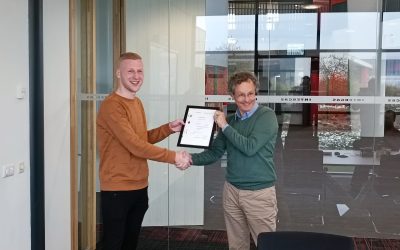Monuta: Complete new process design
Monuta has two main branches: funeral business and funeral insurance.
Monuta has some 100 properties throughout the Netherlands, including funeral homes, crematoria and cemeteries. Because funeral care is very much a local business, Monuta is also strongly represented in local networks and has a franchise formula for entrepreneurs.
Monuta is investing in renewing its ICT landscape. Part of this is the replacement of two outdated systems serving the funeral home and its administration. To make the right choice for the new system and set it up optimally, we worked with Symbol to redesign the (administrative) business process for funeral services.
We spoke with Maarten Kroese, manager of operations. He explains: “The scope of the redesign runs from taking the notification of death to getting the funeral bill paid. The administrative process can be considered a chain that runs between funeral director, through local support by one of the corporate offices and departments at headquarters. Two computer systems are now used for recording information that are severely outdated, resulting in much manual input. Not efficient and quite error-prone. For example, booking a purchase invoice is done manually where a lot of data had to be entered multiple times, VAT codes corrected, etc.
Information is currently often stored in paper form in multiple places so that taking the next process step requires action in terms of email or phone. Paper sub-files are kept everywhere and data is recorded multiple times.
Suboptimal use of resources
The deployment of people and resources for the purpose of a funeral (resource planning) is also handled manually. Because this is not facilitated within the system, things are handled differently at one location than another; from funeral directors planning and arranging everything themselves, to directing corporate offices that plan and assign funerals.
This prompted Monuta to start looking for a new automation system, in which information only needs to be recorded once, the chain is transparent for everyone and which allows processes to be worked with in an unambiguous manner. Last but not least, the system needed to work for the customer. He must be able to look into his file from the first moment, see what has been recorded, what choices are available and be able to make choices, know what his loved one’s funeral wishes were and what any insurance coverage offers.
To arrive at a good system and, in particular, a good design for the system, Monuta first wanted to examine the processes and, if necessary, redesign them. This became the project “CONNeCT. The scope of the project covered the entire process; from taking the notification of death, 24 hours a day 7 days a week, to paying the bill.”
Maarten Kroese continues: “Given the complexity of it all, we wanted to do this process with an external, expert party. We invited a number of consulting organizations to present a plan of action and submit a bid. In the end, we partnered with Symbol. In March 2016, we actually started the CONNeCT project.
The Symbol team consisted of two experienced consultants who started mapping the “IST” situation within our organization. We also had a very good project team internally with expertise, including many colleagues from outside headquarters. This created a lot of insight and provided support. With them, pictures were collected of all kinds of possible input screens of the existing computer systems. Current processes were also identified. This resulted in rooms full of pictures and post-its and sight of lots of areas for improvement. At the beginning of mapping the IST situation, Symbol’s consultants took us through the ideas of Lean Management. We learned about the 8 sources of waste, first time right and standardized work, among others, through a game. This introduction to Lean management allowed us to look at our own process with a very critical eye.
Redesign process
Once we understood this, we started redesigning the processes, the “SOLL” situation. Working more efficiently means, among other things, automating manual operations, standardizing processes, more (central) control in parts, and thus sometimes less freedom for funeral directors and other employees. It became clear that efficient automation is only possible if we also standardize our administrative back-office processes extensively. The thinking of Lean Management also came in handy when we set up the SOLL situation and certainly helped us to set up an ambitious SOLL situation.
‘Customer intimacy’ on the front end and ‘operational excellence’ on the back end
In the desired “SOLL” situation, it became clear that employees will also have to work differently in a number of areas. On the front end, the customer gets more direct influence. We want to design funerals even more together with the client, with a digital platform making that possible to a large extent. This front end will need to connect seamlessly with the back end for information exchange. On the back end (out of the customer’s sight), in the “SOLL” situation, the process is actually designed much more efficiently and is highly automated.
I did learn that you have to understand each other very well as client and contractor, especially in such complex assignments. Because it turned out not to be that simple. The discussions sometimes flew in all directions. We found that we did not have a unified view of several terms that were used internally as a matter of course. For example, a phrase like “local entrepreneurship,” what does that really mean? That turned out to be a little different for everyone. From these discussions, we drafted what we call “Guiding Principles. This was the most difficult part of the overall project, though. Each new process was then based on these defined guiding principles, so it was clear why we made certain choices.
Mastering new skills and knowledge
Different role assignments, changed processes and new systems require employees to acquire (a lot of) new knowledge in the coming period. In this, of course, they are helped by education & training.
The “SOLL” situation was delivered in August. There is a new process design that has been beautifully rendered in an animation for all employees so they can imagine what it will be like. We are ready and we now have enough ammunition for the next step, which is to choose the right ICT solution and implementation partner.
All in all, the CONNeCT project was delivered on time and on budget, delivering not just a redesign, but a redesign with the necessary support. And it was not only something of the headquarters, it was at the same time a good basis for communication between management in the various (local) organizations and departments.
We made a good choice with Symbol. This was also mainly because the two consultants who joined us complemented and reinforced each other very well. One person understood the processes at lightning speed and was able to improve them with our project team. The other consultant’s strength was primarily in change management. She was very good at convincing and getting all stakeholders and upper management to move so that we had broad support for the changed processes. And that is an absolute necessity for a project to succeed!”
Latest news/blogs
From Theory to Practice: Junior Consultant at Stoneridge
From theory to practice: Junior Consultant at Stoneridge Before working at Symbol, Junior...
Optimize Quality Management with AI Tools
Optimize quality management with AI tools In the modern business environment, quality management...
The Netherlands’ youngest Black Belt speaks
A ideal is not yet not a solutionEmiel recently gave a training session on the topic of problem...


